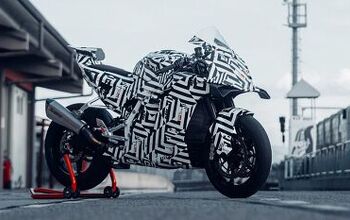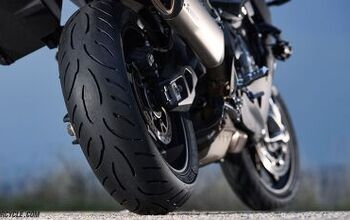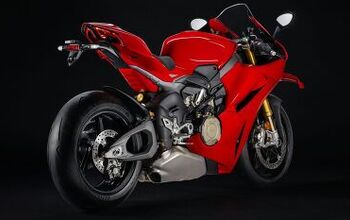Motorcycle Beginner: Buying Your First Motorcycle
I’ve got my license, I’ve got my riding gear, and I’ve been through a rider training program.
Now comes the fun part and one of the most frequently asked questions by new riders: what bike should I get?
Pete Brissette wrote an excellent article on this topic last summer, recommending five good starter bikes (and five alternate choices) covering a variety of motorcycle categories such as cruisers, and dual sports.
Pete also discussed a couple of key points that deserve repeating: the right bike for one person might not be the right bike for another, and a 600cc supersport race replica is not a sensible choice for an inexperienced rider.
The latter point is one frequently repeated by more experienced riders, and yet every now and then, a newbie comes along asking “I’m just starting out as a rider and I’m looking for a first bike. Should I go for the R6 or the ZX-6R?”
I can understand the appeal of these supersports. They’re fast, they’re sexy, and they look like what you see racing the Daytona 200.
On the other hand, they are less forgiving than smaller bikes, cost more to own and insure, and truthfully, they offer higher performance than many people really need.
For this beginner series, our choice for a first bike was made from the outset. The 2011 Honda CBR250R is the shiny new kid on the block, a low-displacement thumper with a high-class finish and the winner of our 2011 250cc Beginner Bike Shootout. As of this writing, I’ve already put in a couple of weeks on the CBR250R, so look for a report on that real soon.
But for most new riders, the Honda CBR250R is one of many options available as an effective, manageable and affordable first bike. So for this segment of the Motorcycle.com Beginner Series, we’ll take a look at some of the options on the market, and examine some of the factors to consider when shopping for your first motorcycle.
What Makes an “Entry-Level” Motorcycle?
There’s no real industry-standardized definition for a beginner bike. Some models might be marketed as being good for new riders, while others may also be good options but a company might feel they would turn away more experienced riders by labeling them as for newbies.
Engine displacement is an easy way many people use to categorize bikes. Some countries have tiered licensing regulations, especially for younger riders, that restrict the size or power output of motorcycles they can legally ride. And while it's true larger engines produce more power, other factors such as engine configuration and tuning must also be considered.
For the most part, we will be looking at the smaller displacement models in a given product segment, but we're not going to stick to a displacement limit. So while we are advising against 600cc Inline-Four supersports like a Honda CBR600RR as a first bike, an 883cc V-Twin Harley-Davidson Sportster is a different matter, despite having a larger engine.
Cost is also an important factor to consider. While there may be some pricier motorcycles that could serve as effective first bikes, a more expensive motorcycle will also be more expensive to insure. A new rider will already face higher insurance premiums than a more seasoned rider, so why add to that burden with a big-ticket motorcycle? Factor in depreciation and the likelihood of new rider dropping their bikes and it makes more sense not to spend too much on your first motorcycle.
On that note, a used motorcycle may also be a better option than a brand new bike. In this case, depreciation works in your favor as a used bike will be less expensive than a new one. There will also be a lot of newbie-friendly motorcycles on the used bike market as former beginners look to sell their own first bike as they upgrade to their second one.
The trade-off with buying a used motorcycle is you have to do some legwork to learn the history of the bike. How good a condition is it in? How many miles has it been ridden? How many owners has the bike had? Did the seller provide proper care and maintenance? New motorcycles straight from the dealership don’t carry any baggage (unless you wanted panniers and a top case, that is!) but they’ll also come with a factory warranty.
Editor's Picks for Pre-Owned Starter BikesThe most cost-effective way to get into motorcycling is to select a pre-owned bike instead of a new one. It's already suffered depreciation, so you won't take as big a hit when you decide to trade up to another motorcycle as your skills and capabilities improve. And pre-owned also often means pre-scuffed, so you won't feel so bad if you tip it over compared to a pristine new bike. What follows are selections from the Motorcycle.com staff about which used bike they'd personally recommend to a beginning rider.
To me the Suzuki SV650 is just about the perfect second-hand motorcycle one can get. First of all, the SV is darn near bulletproof. Very rarely do you hear of its V-Twin engine breaking down, even under extreme negligence. With just 65-70 horsepower, there’s enough oomph to keep things exciting for the newer rider without alarming the local authorities. Also, it’s been around for long enough now that prices on the used market have stabilized. But to me, the real beauty of the SV is its versatility.
Stock, these bikes feature bottom-shelf components (suspension, brakes) to meet its intended price point. This is perfect for less experienced riders as their skills don’t warrant anything better anyway. But as one starts to improve and find the limits of these components, there are a whole host of easy modifications available to upgrade the bike.
And this is why I still have a soft spot for SVs even after I’ve ridden just about every motorcycle under the sun. I learned everything I know about bikes from my SV. As I became a better rider, I upgraded the suspension, then I added an exhaust, and then rejetted the carbs (I have a first generation model). Being that it has very little bodywork, access to everything is straightforward. As time went on and my skills improved I eventually turned it into a full-fledged racebike, but I’ve seen examples modified into everything from streetfighters to cross-country tourers. The SV650 is so easy to ride and maintain, but best of all it’s able to grow with you at every step of your motorcycle journey.
– Troy Siahaan, Associate Editor
Low seat heights are great for short newbie riders, as it gives them a better sense of control. But the diminutive size of many newb bikes makes them cramped for bigger and taller riders. For newbie riders my size and larger (5-foot-11, 185 lbs),I suggest looking into the world of enduro motorcycles.
Another advantage of owning an enduro bike is inexpensive insurance; they’re one of the easiest street-legal motorcycles on which to complete a motorcycle training program and/or DMV test. Best of all, there’s not much to break in the event of a fall. Enduros are glorified dirtbikes and are built for off-road use with minimal bodywork and lacking other expensive-to-replace items.
Enduro bikes have existed for decades, so there’s a lot of cheap, used models from which to choose. Enduros are (mostly) powered by simple, single-cylinder, air-cooled engines where everything is exposed and easy to work on, so they also provide a terrific platform for learning basic motorcycle maintenance.
– Tom Roderick, Content Editor
The problem with so many beginner bikes is that they frequently lack a cool factor. Sure, we know a beginner’s ride should have docile but adequate power and comfortable ergonomics, but it would help our street cred if our newb-friendly machine had some style. Cruisers have style, but their ergonomics often feel unwieldy to new riders.
My solution is Kawasaki’s almost-forgotten W650, a facsimile of a vintage Triumph Bonneville more authentic than even New Triumph’s version. Powered by a 676cc parallel-Twin engine and produced in 2000-2001, the air-cooled W harks back to a simpler time yet provides more than enough punch for keeping up with freeway traffic. Nostalgic references include spoked wheels, fork gaiters and chrome fenders – not to mention an honest-to-goodness kickstarter! It’s really nimble and easy to ride, and it never fails to draw admiring glances.
When we tested a year-2000 version, the W650 retailed on the high end for $6499, and the bike’s unique attributes and limited production run has kept resale prices fairly high. NADA Guides list’s a sub-$2000 price, but speculators often ask much more. Regardless, this is a terrific motorcycle that allows its rider to recreate a little of the persona of Marlon Brando’s character in The Wild One.
– Kevin Duke, Editor-in-Chief
More by Dennis Chung

































Comments
Join the conversation